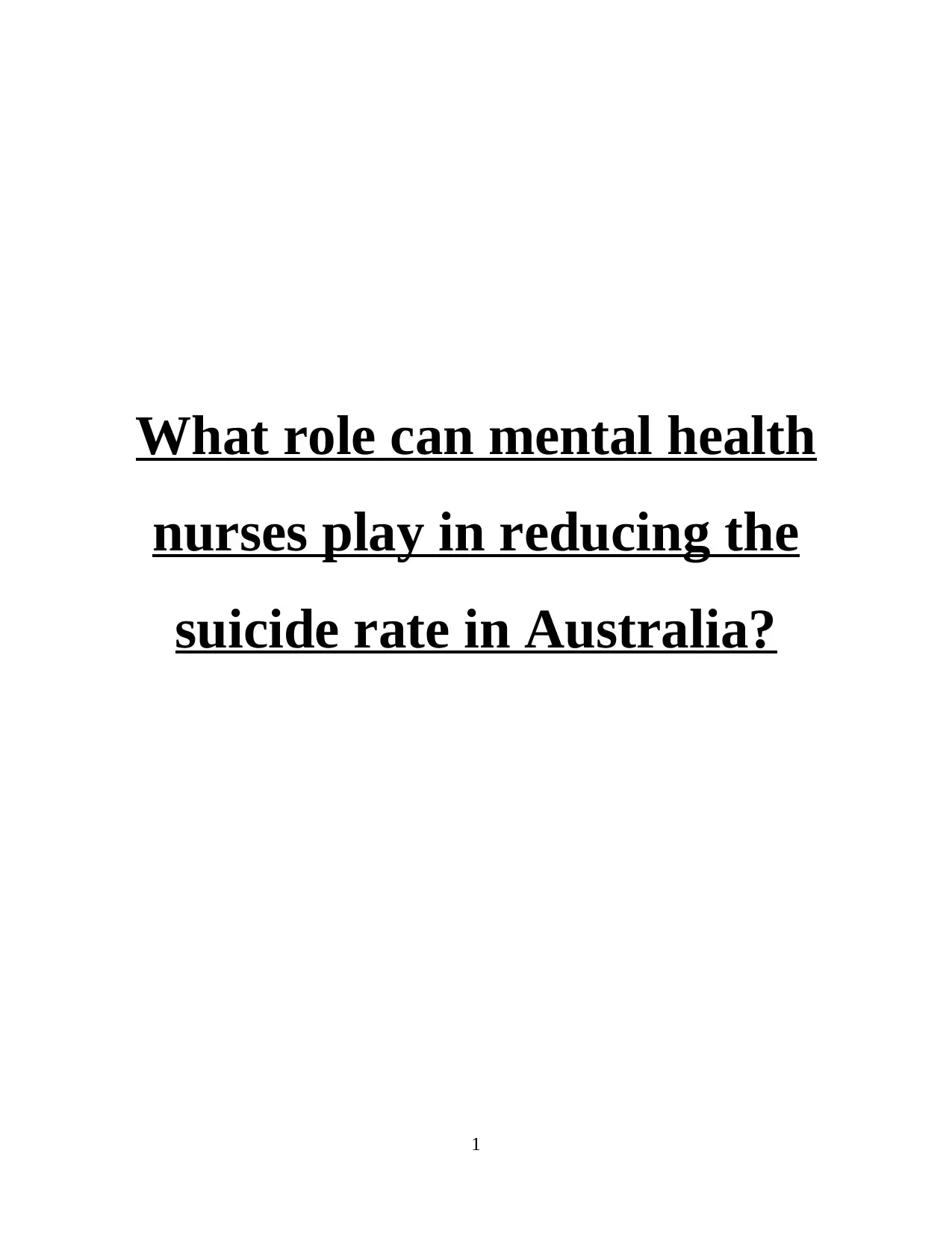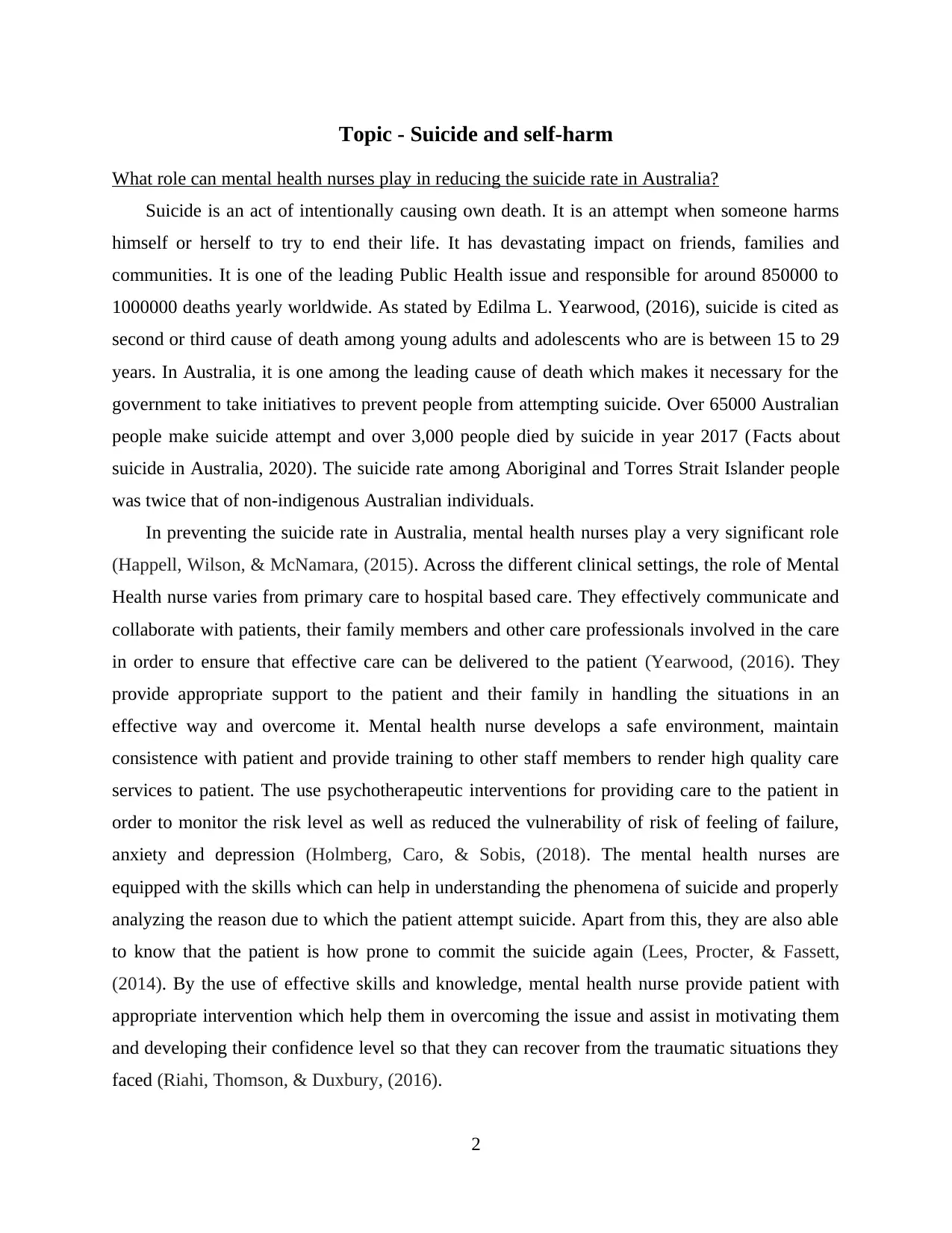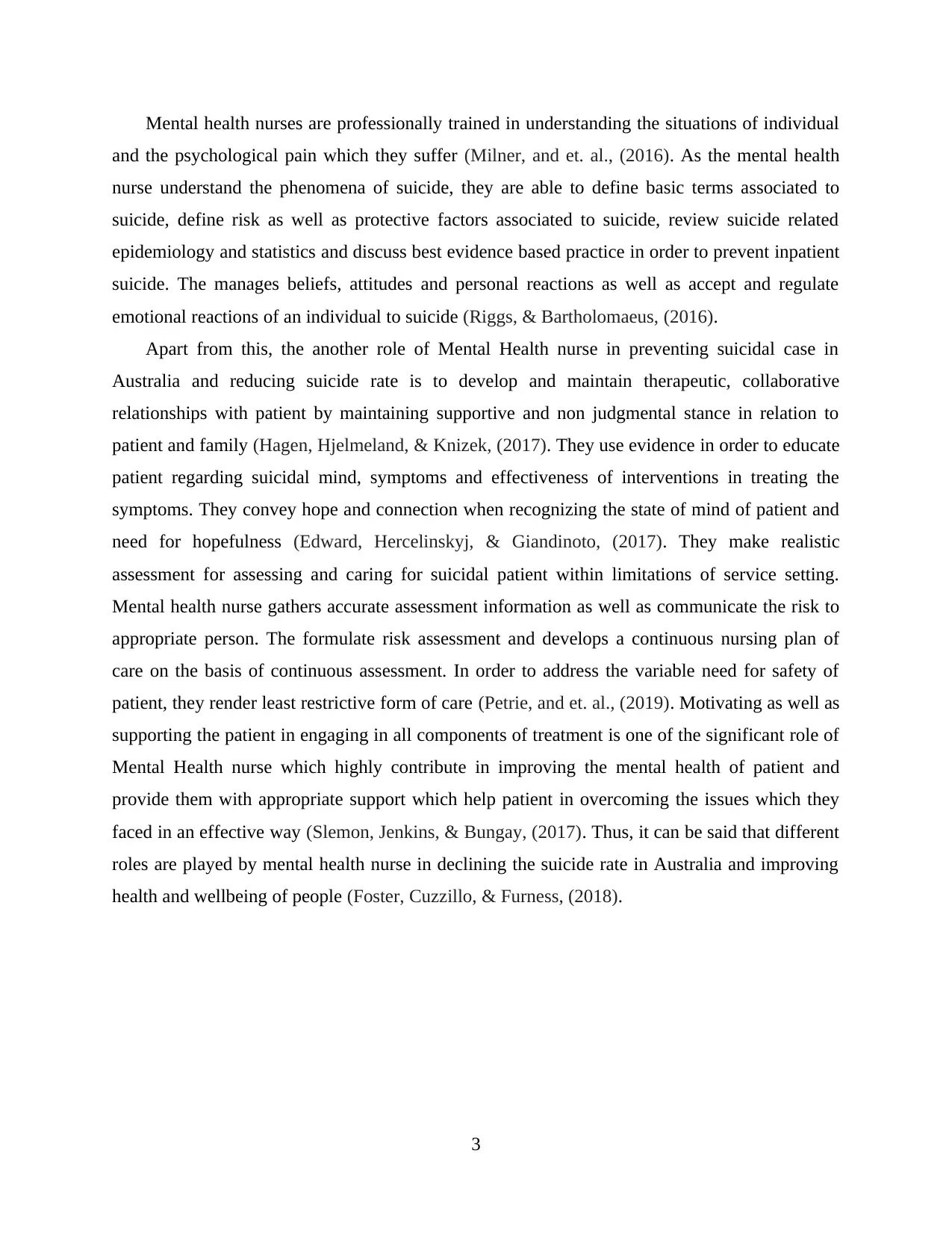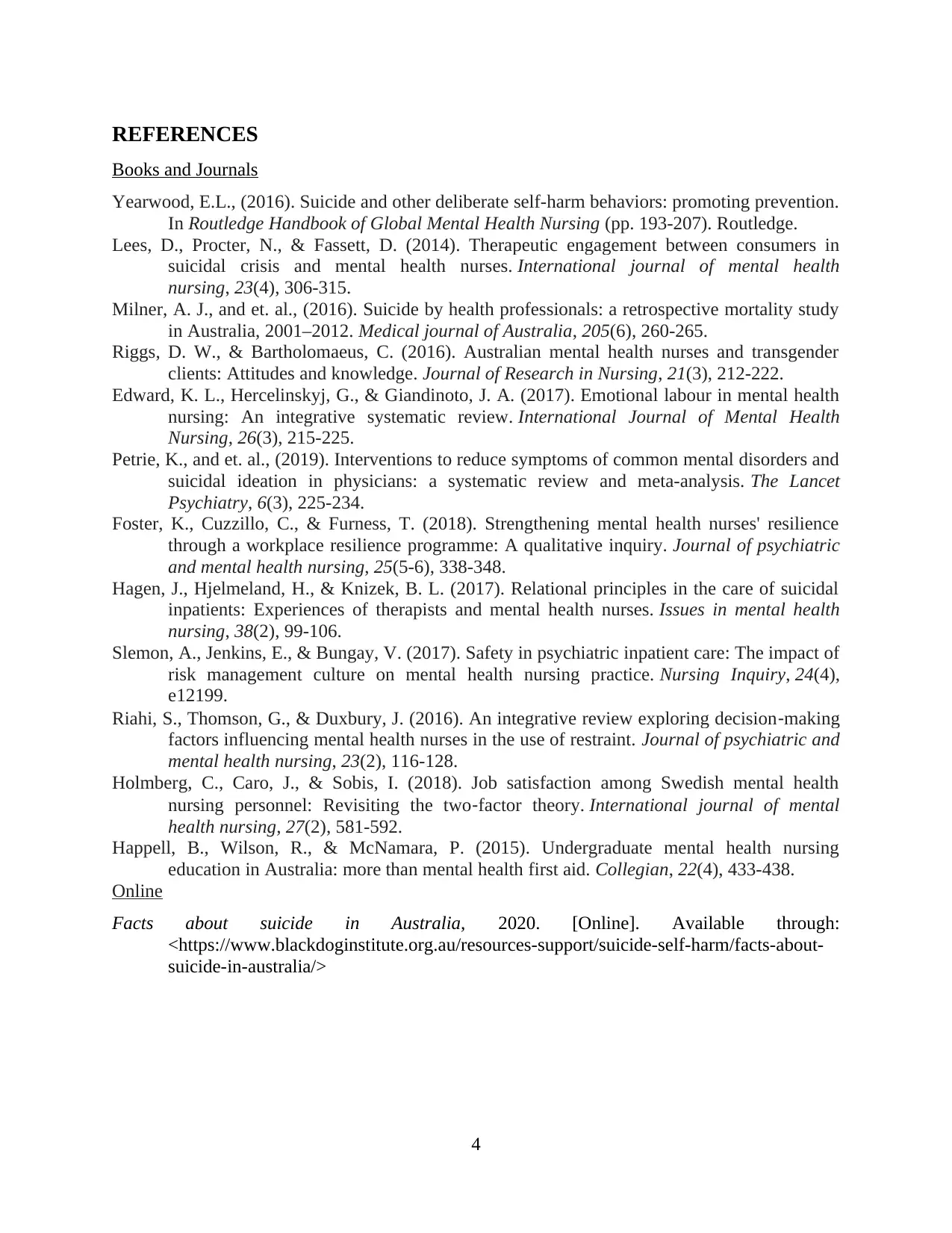Mental Health Nurses' Role in Suicide Rate Reduction in Australia
VerifiedAdded on 2023/01/03
|4
|1463
|98
Report
AI Summary
This report investigates the pivotal role of mental health nurses in mitigating the suicide rate within Australia. It emphasizes the multifaceted responsibilities of these professionals, which range from establishing secure environments and maintaining consistent patient interactions to delivering staff training aimed at providing high-quality care. The report underscores the significance of psychotherapeutic interventions in risk monitoring, reducing vulnerability, and addressing feelings of failure, anxiety, and depression. Furthermore, it highlights the nurses' proficiency in understanding the complexities of suicide, conducting thorough risk assessments, and providing appropriate interventions to motivate patients and bolster their confidence. The report also stresses the nurses' role in developing therapeutic, collaborative relationships, educating patients, and supporting them throughout their treatment, ultimately contributing to improved mental health outcomes and a reduction in suicide rates. The report references various journals and books to support its findings.

What role can mental health
nurses play in reducing the
suicide rate in Australia?
1
nurses play in reducing the
suicide rate in Australia?
1
Paraphrase This Document
Need a fresh take? Get an instant paraphrase of this document with our AI Paraphraser

Topic - Suicide and self-harm
What role can mental health nurses play in reducing the suicide rate in Australia?
Suicide is an act of intentionally causing own death. It is an attempt when someone harms
himself or herself to try to end their life. It has devastating impact on friends, families and
communities. It is one of the leading Public Health issue and responsible for around 850000 to
1000000 deaths yearly worldwide. As stated by Edilma L. Yearwood, (2016), suicide is cited as
second or third cause of death among young adults and adolescents who are is between 15 to 29
years. In Australia, it is one among the leading cause of death which makes it necessary for the
government to take initiatives to prevent people from attempting suicide. Over 65000 Australian
people make suicide attempt and over 3,000 people died by suicide in year 2017 (Facts about
suicide in Australia, 2020). The suicide rate among Aboriginal and Torres Strait Islander people
was twice that of non-indigenous Australian individuals.
In preventing the suicide rate in Australia, mental health nurses play a very significant role
(Happell, Wilson, & McNamara, (2015). Across the different clinical settings, the role of Mental
Health nurse varies from primary care to hospital based care. They effectively communicate and
collaborate with patients, their family members and other care professionals involved in the care
in order to ensure that effective care can be delivered to the patient (Yearwood, (2016). They
provide appropriate support to the patient and their family in handling the situations in an
effective way and overcome it. Mental health nurse develops a safe environment, maintain
consistence with patient and provide training to other staff members to render high quality care
services to patient. The use psychotherapeutic interventions for providing care to the patient in
order to monitor the risk level as well as reduced the vulnerability of risk of feeling of failure,
anxiety and depression (Holmberg, Caro, & Sobis, (2018). The mental health nurses are
equipped with the skills which can help in understanding the phenomena of suicide and properly
analyzing the reason due to which the patient attempt suicide. Apart from this, they are also able
to know that the patient is how prone to commit the suicide again (Lees, Procter, & Fassett,
(2014). By the use of effective skills and knowledge, mental health nurse provide patient with
appropriate intervention which help them in overcoming the issue and assist in motivating them
and developing their confidence level so that they can recover from the traumatic situations they
faced (Riahi, Thomson, & Duxbury, (2016).
2
What role can mental health nurses play in reducing the suicide rate in Australia?
Suicide is an act of intentionally causing own death. It is an attempt when someone harms
himself or herself to try to end their life. It has devastating impact on friends, families and
communities. It is one of the leading Public Health issue and responsible for around 850000 to
1000000 deaths yearly worldwide. As stated by Edilma L. Yearwood, (2016), suicide is cited as
second or third cause of death among young adults and adolescents who are is between 15 to 29
years. In Australia, it is one among the leading cause of death which makes it necessary for the
government to take initiatives to prevent people from attempting suicide. Over 65000 Australian
people make suicide attempt and over 3,000 people died by suicide in year 2017 (Facts about
suicide in Australia, 2020). The suicide rate among Aboriginal and Torres Strait Islander people
was twice that of non-indigenous Australian individuals.
In preventing the suicide rate in Australia, mental health nurses play a very significant role
(Happell, Wilson, & McNamara, (2015). Across the different clinical settings, the role of Mental
Health nurse varies from primary care to hospital based care. They effectively communicate and
collaborate with patients, their family members and other care professionals involved in the care
in order to ensure that effective care can be delivered to the patient (Yearwood, (2016). They
provide appropriate support to the patient and their family in handling the situations in an
effective way and overcome it. Mental health nurse develops a safe environment, maintain
consistence with patient and provide training to other staff members to render high quality care
services to patient. The use psychotherapeutic interventions for providing care to the patient in
order to monitor the risk level as well as reduced the vulnerability of risk of feeling of failure,
anxiety and depression (Holmberg, Caro, & Sobis, (2018). The mental health nurses are
equipped with the skills which can help in understanding the phenomena of suicide and properly
analyzing the reason due to which the patient attempt suicide. Apart from this, they are also able
to know that the patient is how prone to commit the suicide again (Lees, Procter, & Fassett,
(2014). By the use of effective skills and knowledge, mental health nurse provide patient with
appropriate intervention which help them in overcoming the issue and assist in motivating them
and developing their confidence level so that they can recover from the traumatic situations they
faced (Riahi, Thomson, & Duxbury, (2016).
2

Mental health nurses are professionally trained in understanding the situations of individual
and the psychological pain which they suffer (Milner, and et. al., (2016). As the mental health
nurse understand the phenomena of suicide, they are able to define basic terms associated to
suicide, define risk as well as protective factors associated to suicide, review suicide related
epidemiology and statistics and discuss best evidence based practice in order to prevent inpatient
suicide. The manages beliefs, attitudes and personal reactions as well as accept and regulate
emotional reactions of an individual to suicide (Riggs, & Bartholomaeus, (2016).
Apart from this, the another role of Mental Health nurse in preventing suicidal case in
Australia and reducing suicide rate is to develop and maintain therapeutic, collaborative
relationships with patient by maintaining supportive and non judgmental stance in relation to
patient and family (Hagen, Hjelmeland, & Knizek, (2017). They use evidence in order to educate
patient regarding suicidal mind, symptoms and effectiveness of interventions in treating the
symptoms. They convey hope and connection when recognizing the state of mind of patient and
need for hopefulness (Edward, Hercelinskyj, & Giandinoto, (2017). They make realistic
assessment for assessing and caring for suicidal patient within limitations of service setting.
Mental health nurse gathers accurate assessment information as well as communicate the risk to
appropriate person. The formulate risk assessment and develops a continuous nursing plan of
care on the basis of continuous assessment. In order to address the variable need for safety of
patient, they render least restrictive form of care (Petrie, and et. al., (2019). Motivating as well as
supporting the patient in engaging in all components of treatment is one of the significant role of
Mental Health nurse which highly contribute in improving the mental health of patient and
provide them with appropriate support which help patient in overcoming the issues which they
faced in an effective way (Slemon, Jenkins, & Bungay, (2017). Thus, it can be said that different
roles are played by mental health nurse in declining the suicide rate in Australia and improving
health and wellbeing of people (Foster, Cuzzillo, & Furness, (2018).
3
and the psychological pain which they suffer (Milner, and et. al., (2016). As the mental health
nurse understand the phenomena of suicide, they are able to define basic terms associated to
suicide, define risk as well as protective factors associated to suicide, review suicide related
epidemiology and statistics and discuss best evidence based practice in order to prevent inpatient
suicide. The manages beliefs, attitudes and personal reactions as well as accept and regulate
emotional reactions of an individual to suicide (Riggs, & Bartholomaeus, (2016).
Apart from this, the another role of Mental Health nurse in preventing suicidal case in
Australia and reducing suicide rate is to develop and maintain therapeutic, collaborative
relationships with patient by maintaining supportive and non judgmental stance in relation to
patient and family (Hagen, Hjelmeland, & Knizek, (2017). They use evidence in order to educate
patient regarding suicidal mind, symptoms and effectiveness of interventions in treating the
symptoms. They convey hope and connection when recognizing the state of mind of patient and
need for hopefulness (Edward, Hercelinskyj, & Giandinoto, (2017). They make realistic
assessment for assessing and caring for suicidal patient within limitations of service setting.
Mental health nurse gathers accurate assessment information as well as communicate the risk to
appropriate person. The formulate risk assessment and develops a continuous nursing plan of
care on the basis of continuous assessment. In order to address the variable need for safety of
patient, they render least restrictive form of care (Petrie, and et. al., (2019). Motivating as well as
supporting the patient in engaging in all components of treatment is one of the significant role of
Mental Health nurse which highly contribute in improving the mental health of patient and
provide them with appropriate support which help patient in overcoming the issues which they
faced in an effective way (Slemon, Jenkins, & Bungay, (2017). Thus, it can be said that different
roles are played by mental health nurse in declining the suicide rate in Australia and improving
health and wellbeing of people (Foster, Cuzzillo, & Furness, (2018).
3
⊘ This is a preview!⊘
Do you want full access?
Subscribe today to unlock all pages.

Trusted by 1+ million students worldwide

REFERENCES
Books and Journals
Yearwood, E.L., (2016). Suicide and other deliberate self-harm behaviors: promoting prevention.
In Routledge Handbook of Global Mental Health Nursing (pp. 193-207). Routledge.
Lees, D., Procter, N., & Fassett, D. (2014). Therapeutic engagement between consumers in
suicidal crisis and mental health nurses. International journal of mental health
nursing, 23(4), 306-315.
Milner, A. J., and et. al., (2016). Suicide by health professionals: a retrospective mortality study
in Australia, 2001–2012. Medical journal of Australia, 205(6), 260-265.
Riggs, D. W., & Bartholomaeus, C. (2016). Australian mental health nurses and transgender
clients: Attitudes and knowledge. Journal of Research in Nursing, 21(3), 212-222.
Edward, K. L., Hercelinskyj, G., & Giandinoto, J. A. (2017). Emotional labour in mental health
nursing: An integrative systematic review. International Journal of Mental Health
Nursing, 26(3), 215-225.
Petrie, K., and et. al., (2019). Interventions to reduce symptoms of common mental disorders and
suicidal ideation in physicians: a systematic review and meta-analysis. The Lancet
Psychiatry, 6(3), 225-234.
Foster, K., Cuzzillo, C., & Furness, T. (2018). Strengthening mental health nurses' resilience
through a workplace resilience programme: A qualitative inquiry. Journal of psychiatric
and mental health nursing, 25(5-6), 338-348.
Hagen, J., Hjelmeland, H., & Knizek, B. L. (2017). Relational principles in the care of suicidal
inpatients: Experiences of therapists and mental health nurses. Issues in mental health
nursing, 38(2), 99-106.
Slemon, A., Jenkins, E., & Bungay, V. (2017). Safety in psychiatric inpatient care: The impact of
risk management culture on mental health nursing practice. Nursing Inquiry, 24(4),
e12199.
Riahi, S., Thomson, G., & Duxbury, J. (2016). An integrative review exploring decision‐making
factors influencing mental health nurses in the use of restraint. Journal of psychiatric and
mental health nursing, 23(2), 116-128.
Holmberg, C., Caro, J., & Sobis, I. (2018). Job satisfaction among Swedish mental health
nursing personnel: Revisiting the two‐factor theory. International journal of mental
health nursing, 27(2), 581-592.
Happell, B., Wilson, R., & McNamara, P. (2015). Undergraduate mental health nursing
education in Australia: more than mental health first aid. Collegian, 22(4), 433-438.
Online
Facts about suicide in Australia, 2020. [Online]. Available through:
<https://www.blackdoginstitute.org.au/resources-support/suicide-self-harm/facts-about-
suicide-in-australia/>
4
Books and Journals
Yearwood, E.L., (2016). Suicide and other deliberate self-harm behaviors: promoting prevention.
In Routledge Handbook of Global Mental Health Nursing (pp. 193-207). Routledge.
Lees, D., Procter, N., & Fassett, D. (2014). Therapeutic engagement between consumers in
suicidal crisis and mental health nurses. International journal of mental health
nursing, 23(4), 306-315.
Milner, A. J., and et. al., (2016). Suicide by health professionals: a retrospective mortality study
in Australia, 2001–2012. Medical journal of Australia, 205(6), 260-265.
Riggs, D. W., & Bartholomaeus, C. (2016). Australian mental health nurses and transgender
clients: Attitudes and knowledge. Journal of Research in Nursing, 21(3), 212-222.
Edward, K. L., Hercelinskyj, G., & Giandinoto, J. A. (2017). Emotional labour in mental health
nursing: An integrative systematic review. International Journal of Mental Health
Nursing, 26(3), 215-225.
Petrie, K., and et. al., (2019). Interventions to reduce symptoms of common mental disorders and
suicidal ideation in physicians: a systematic review and meta-analysis. The Lancet
Psychiatry, 6(3), 225-234.
Foster, K., Cuzzillo, C., & Furness, T. (2018). Strengthening mental health nurses' resilience
through a workplace resilience programme: A qualitative inquiry. Journal of psychiatric
and mental health nursing, 25(5-6), 338-348.
Hagen, J., Hjelmeland, H., & Knizek, B. L. (2017). Relational principles in the care of suicidal
inpatients: Experiences of therapists and mental health nurses. Issues in mental health
nursing, 38(2), 99-106.
Slemon, A., Jenkins, E., & Bungay, V. (2017). Safety in psychiatric inpatient care: The impact of
risk management culture on mental health nursing practice. Nursing Inquiry, 24(4),
e12199.
Riahi, S., Thomson, G., & Duxbury, J. (2016). An integrative review exploring decision‐making
factors influencing mental health nurses in the use of restraint. Journal of psychiatric and
mental health nursing, 23(2), 116-128.
Holmberg, C., Caro, J., & Sobis, I. (2018). Job satisfaction among Swedish mental health
nursing personnel: Revisiting the two‐factor theory. International journal of mental
health nursing, 27(2), 581-592.
Happell, B., Wilson, R., & McNamara, P. (2015). Undergraduate mental health nursing
education in Australia: more than mental health first aid. Collegian, 22(4), 433-438.
Online
Facts about suicide in Australia, 2020. [Online]. Available through:
<https://www.blackdoginstitute.org.au/resources-support/suicide-self-harm/facts-about-
suicide-in-australia/>
4
1 out of 4
Related Documents
Your All-in-One AI-Powered Toolkit for Academic Success.
+13062052269
info@desklib.com
Available 24*7 on WhatsApp / Email
![[object Object]](/_next/static/media/star-bottom.7253800d.svg)
Unlock your academic potential
Copyright © 2020–2025 A2Z Services. All Rights Reserved. Developed and managed by ZUCOL.




